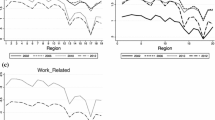Abstract
This study deals with the importance of the correct definition and identification of the consumption variable to obtain a good description of consumer behaviour, and shows how the new definitions of consumption introduced by the 1995 European System of Accounts (ESA) provide a better descriptive capability of the classic multiequational models of consumption compared with the definition and concept of the 1979 ESA. The models used are the Rotterdam Model, the Linear Expenditure System, and the Almost Ideal Demand System. Cointegration techniques have been applied to estimate Almost Ideal Demand System parameters. Data on Italian final consumption expenditure of households have been used.
Similar content being viewed by others
References
Adrian CD (1997) A dictionary of econometrics. Edward Elgar Publishing Limited, Cheltenham
Anderson G, Blundell R (1982) Estimation and hypothesis testing in dynamic singular equation systems. Econometrica 50: 1559–1571
Anderson G, Blundell R (1983) Testing restrictions in a flexible dynamic demand system: an application to consumer demand in Canada. Rev Econ Stud 50: 397–410
Anderson G, Blundell R (1984) Consumer non-durables in the UK: a dynamic demand system. Econ J Suppl 94: 35–44
Atella V, Menon M, Perali F (2003) Estimation of unit values in cross sections without quantity information and implications for demand and welfare analysis. In: Ferrarie G, Dagum G (eds) Household welfare and poverty. Springer, Heidelberg
Barten AP (1964) Consumer demand functions under conditions of almost additive preferences. Econometrica 2: 1–38
Barten AP (1968) Estimating demand equations. Econometrica 36: 213–251
Barten AP (1969) Maximum likelihood estimation of complete systems of demand equations. Eur Econ Rev 1: 7–73
Belsey DA, Kuh E, Welsch RE (1980) Regression diagnostic, identifying influential data and sources of collinearity. Wiley, New York
Breusch TS, Pagan AR (1979) A simple test for heteroskedasticity and random coefficient variation. Econometrica 47(5): 1287–1294
Breusch TS, Pagan AR (1980) The LM test and its application to model specification in econometrics. Rev Econ Stud 47: 239–254
Christensen LR, Jorgenson DW, Lau LJ (1975) Transcendental logarithmic utility functions. Am Econ Rev 65: 519–530
Collesi D, Di Leo F (2000) Spesa per consumi e consumi individuali. Nuovi strumenti per una misura del benessere delle famiglie e delle funzioni delle AP. Paper presented at the seminar “La nuova contabilità nazionale”, ISTAT, Roma, 12–13 January
Davidson R, MacKinnon JG (1981) Several tests for model specification in the presence of alternative hypothesis. Econometrica 49: 781–793
Deaton AS (1974) The analysis of consumer demand in the United Kingdom 1900–1970. Econometrica 42: 341–367
Deaton AS, Muellbauer J (1980) An almost ideal demand system. Am Econ Rev 70: 312–326
Engle RF, Granger CWJ (1987) Cointegration and error correction: representation, estimation and testing. Econometrica 55: 251–276
EUROSTAT (1995) European System of Accounts ESA 1995, L-2920, Luxembourg
Fanelli L, Mazzocchi M (2002) A cointegrated VECM demand system for meat in Italy. Appl Econ 34: 1593–1605
Gallant AR (1987) Nonlinear statistical models. John Wiley and Sons, Inc., New York
Godfrey LG (1988) Misspecification tests in econometrics. Cambridge University Press, Cambridge
Greene WH (1993) Econometric analysis. Macmillan Publishing Company Inc., New York
Gregory AW, Veall MR (1985) On formulating Wald tests for nonlinear restrictions. Econometrica 53: 1465–1468
Henze N, Zirkler B (1990) A class of invariant consistent tests for multivariate normality. Commun Stat Theory Methods 19(10): 3595–3617
ISTAT (2000) Le nuove stime dei consumi finali delle famiglie. Secondo il sistema europeo dei conti ‘95. Collana Metodi e Norme, n. 7. ISTAT, Roma
ISTAT (2004a) Inventario sulle fonti e i metodi di calcolo per le valutazioni a prezzi costanti, Collana Metodi e Norme n. 19, ISTAT, Roma
ISTAT (2004b) Metodologie di stima degli aggregati di contabilità nazionale a prezzi correnti, Italia - Inventario Sec 95, Collana Metodi e Norme, n. 21, ISTAT
Judge G, Griffiths W, Cartel Hill R, Lutkepohl H, Lee T (1980) The theory and practice of econometrics. Wiley, New York
Karagiannis G, Katranidis S, Velentzas K (2000) An error correction almost ideal system formeat in Greece. Agric Econ 22: 29–35
Karagiannis G, Mergos GJ (2002) Estimating theoretically consistent demand systems using cointegration techniques with application to Greek food data. Econ Lett 74: 137–143
Massey FJ Jr (1951) The Kolmogorov–Smirnov test of goodness of fit. In J Am Stat Assov 46: 68–78
Moore EH (1920) On the reciprocal of the general algebraic matrix. Bull Am Math Soc 26: 394–395
Muellbauer J, Pashardes P (1992) Tests of dynamic specification and homogeneity in demand systems. In: Philips L, Taylor LD (eds) Aggregation, consumption and trade: essays in honour of Hendrik Houthakker. Kluwer Academic Publishers, Amsterdam, pp 55–98
Ng S (1995) Testing for homogeneity in demand systems when the regressors are nonstationary, in. J Appl Econ 10: 147–163
Nzuma JM, Sarker R (2008) An error corrected almost ideal demand system for major cereals in Kenya. Selected paper prepared for presentation at the American agricultural economics association annual meeting, Orlando, July 27–29
OECD (1998) Classification of individual consumption by purpose. OECD/COICOP/06.98, Luxembourg
Powell AA (1973) Empirical analytics of demand system. Lexington Books, Massachusetts
Shapiro SS, Wilk MB (1965) An analysis of variance tests for normality (complete samples). Biometrika 52: 591–611
Solari L, De Pasquier JN (1976) Private and enlarged consumption: essay in methodology and empirical analysis. North-Holland Pub. Co., Amsterdam
Stone R (1954) Linear expenditure system and demand analysis: an application to the pattern of British demand. Econ J LXIV: 511–527
Theil H (1965) The information approach to demand analysis. Econometrica 33: 67–87
Theil H (1975) Theory and measurement of consumer demand analysis. North–Holland, Amsterdam
Thomas RL (1993) Introductory econometrics: theory and applications. Longman, London
Tridimas G (2000) The analysis of consumer demand in Greece. Model selection and dynamic specification. Econ Model 17: 455–471
United Nations, EUROSTAT, IMF, World Bank (1993) System of National Accounts 1993. Brussels, Luxembourg, New York, Paris, Washington DC
Author information
Authors and Affiliations
Corresponding author
Rights and permissions
About this article
Cite this article
Nicolardi, V. The effects of the new 1995 ESA methodologies of estimation on the structural analysis of Italian consumption. Stat Methods Appl 18, 125–149 (2009). https://doi.org/10.1007/s10260-008-0109-5
Accepted:
Published:
Issue Date:
DOI: https://doi.org/10.1007/s10260-008-0109-5




